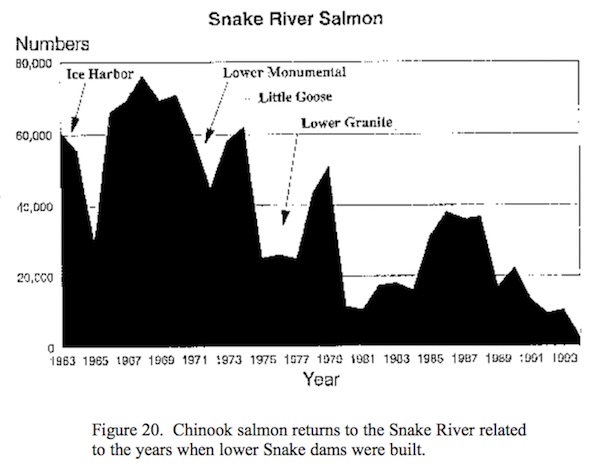forum
library
tutorial
contact

The Science is Clear on Restoring
Wild Salmon in the Snake River Basin
by Rick Williams
East Oregonian, July 22, 2023
|
the film forum library tutorial contact |

|
The Science is Clear on Restoring
by Rick Williams
|
As a fisheries scientist who has spent my professional life studying Pacific salmon and steelhead,
I'm appalled by misinformation being shared under the guise of "science."
 Snake River salmon are not thriving. They're on the brink of extinction.
Snake River salmon are not thriving. They're on the brink of extinction.
Since the four Snake River dams were completed in the 1970s, Snake River salmon runs that once produced nearly half the spring Chinook salmon and summer steelhead from the Columbia Basin have suffered sustained and precipitous declines. Today, all remaining salmon and steelhead populations that return to the Snake River are listed as threatened or endangered under the Endangered Species Act. Some have already gone extinct.
Salmon are critical to healthy ecosystems and our life in the Northwest, especially to Tribal Nations to whom we owe an obligation to restore these once-abundant runs. These iconic fish could disappear in our lifetime -- or begin to recover. The choice is ours.
The science is clear on the problems Snake River salmon and steelhead face and the solution. Hydroelectric dams and reservoirs are by far their largest source of human-caused mortality. Recently (2022), federal salmon experts, consistent with dozens of scientific studies, unequivocally recommended removal of the lower Snake River dams as "essential" and a "centerpiece action" to avoid extinction and rebuild salmon to a healthy abundance.
However, as we get closer to charting a path to river restoration and dam removal, opponents are doing all they can to cast doubt on this clear scientific consensus.
At a recent congressional hearing in Richland, Washington, speakers claimed Snake River salmon runs are improving. This is false. While natural variability may return more salmon some years, the overall trend is unequivocally downward despite billions spent to change that trajectory.
Salmon scientists have collected decades of data on salmon returns. SARs, the ratio of migrating smolts to returning adults, give us a critical metric to measure dam impacts and salmon status. For every 100 juvenile smolts typically produced by a breeding pair, at least two adult returns (2% SAR) are needed to replace the breeding pair, while a minimum of 4-6 returning adults (4-6% SARs) are needed to rebuild depressed runs.
For the past 20 years, SARs for Snake River Spring Chinook migrating past eight dams have been less than 1%. Snake River steelhead SARs average just over 1%. Without immediate action to reverse these trends, the next stop is extinction. The Snake River dams are the biggest reason why.
This month, port and shipping interests released a literature review they commissioned to highlight uncertainty in quantifying "delayed mortality" -- juvenile salmon that die prematurely in the estuary or ocean from being weakened by passing the gauntlet of dams. While it's true we can't precisely quantify the level of delayed mortality, that misses the point.
Delayed mortality from dam passage is well-established. According to the Fish Passage Center, each dam a juvenile salmon encounters increases mortality risk by 10% to 15%. And that doesn't include the harm from the warm, slow-moving reservoirs above each dam. Arguing delayed mortality requires more study when action to restore the lower Snake River is so urgently needed is pure distraction.
Critics of dam removal also say poor ocean conditions due to climate change are why Snake River salmon are headed to extinction. Climate is indeed an important factor. But this ignores the fact that salmon returning to other Columbia River tributaries that swim past only three or four dams have SARs well above 2% and as high as 4% in some years.
The SARs tell the story that matters: passage through four dams or fewer allows SARS that equal maintaining and rebuilding salmon populations. Passage through eight dams yields SARs that point to imminent extinction. Clearly, the fewer dams and the more juvenile salmon we can get to the ocean in good condition, the better chance we have of getting more adults back to their spawning grounds regardless of ocean conditions.
As a fisheries scientist who has spent my professional life studying Pacific salmon and steelhead, I'm appalled by misinformation being shared under the guise of "science." Salmon are not doing fine and we know -- based on scientific consensus -- that breaching the Snake River dams is a necessary and critical step to restore salmon and steelhead before it's too late.
Without restoring a free-flowing lower Snake River, we will not stop their extinction.
Related Pages:
Report: Not Enough Information on Delayed Mortality for Fish, Snake River Dams by Matthew Weaver, Capital Press, 7/27/23
Hydropower Advocate Crosses Swords with Anti-Dam Activists by Don Jenkins, Capital Press, 6/30/23
McMorris Rodgers, Others Tour Ice Harbor by Abigail Beaton, Cheney Free Press, 6/29/23
Environmentalists, Politicians Clash Over Republican Hearing to Defend Snake River Dams by Ellen Dennis, Spokesman-Review, 6/28/23
McMorris Rodgers, Newhouse Support Efforts to Retain Home-State's Lower Snake River Dams by News Service, Ripon Advance, 6/28/23
Watch Congressional Republicans Defend Snake River Dams as Calls for Removal Mount by Courtney Flatt, Oregon Public Broadcasting, 6/27/23
Congressional Field Hearing in Richland Focuses on Snake River Dam Breaching by Bob Brawdy, Tri-City Herald, 6/27/23
Newhouse Leads Field Hearing on Snake River Dams by Gabriel Davis, Columbia Basin Herald, 6/26/23
Rep. Newhouse Defends Lower Snake River Dams, Highlights Benefits During Tri-Cities Visit by Jedediah Hoyt, KEPR, 6/26/23
Watch Congressman Newhouse Holds Press Conference on Snake River Dams by Inga Araya, NBC Right Now, 6/26/23
learn more on topics covered in the film
see the video
read the script
learn the songs
discussion forum
